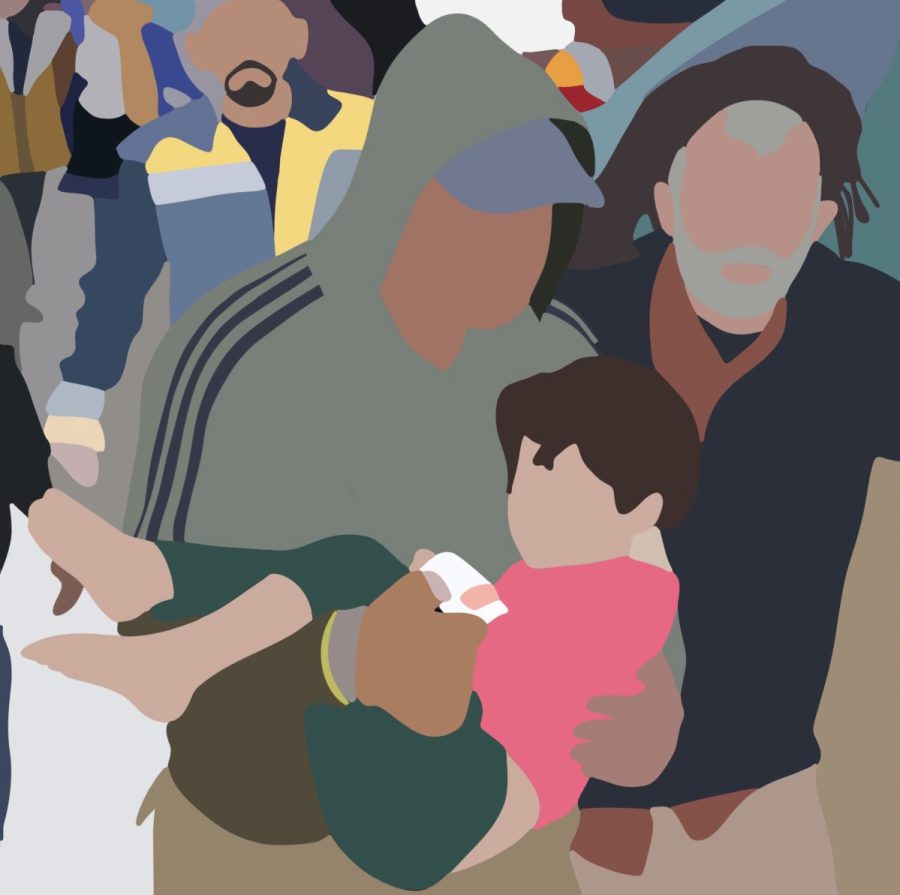Turkey Earthquakes Kill Thousands
A man carries a little girl to safety in Jandaris, Syria following the initial earthquake on Feb. 6. The 7.8 magnitude quake has led to a death toll of over 50,000 and over $1 billion in damages.
On Feb. 6, at four a.m., Turkey, a country crossed by multiple geological fault lines, was awoken by a 7.8 magnitude earthquake, the strongest it has experienced in over 80 years. The epicenter of both the quake, and its 7.5 magnitude aftershock was near the city of Gaziantep in south central Turkey. Homes, hospitals, and even a 2,000-year-old castle suffered irreparable damage, forcing survivors out onto the streets in the middle of a frigid winter. Tents and makeshift shelters can be seen lining parks, sidewalks, and mosque courtyards. As the death toll of both Turkey and its neighboring nation, Syria, continues to climb past 50,000, leaders are struggling to create a plan to put the pieces back together (The New York Times).
While a disaster of this magnitude would have been devastating regardless of where it struck, Turkey and Syria are already in the midst of navigating life following the ceasefire called on the Syrian civil war, complicating relief efforts. In 2020, Syria brought its decade-long civil war to a pause following the outbreak of the coronavirus. Little has been done since then to rebuild, making the nation even more vulnerable. A spokesman for the International Rescue Committee explained, “Anywhere else this would be an emergency. What we have in Syria is an emergency within an emergency” (New York Times).
Another byproduct of the ceasefire was a massive surge of Syrian refugees flooding into Turkey. At the end of 2010, prior to the beginning of the war in Syria, Turkey was home to only 10,000 refugees. 12 years later and it is host to over 3.6 million Syrians, as well as immigrants from Africa, Central Asia, the Middle East, and Russia. This large percentage of the population who were housed in temporary living quarters will have a much more difficult time recovering from the destruction (The New York Times).
It seems as though Turkey’s geographical proneness to earthquakes would have left the country better equipped to structurally withstand the disaster. As recently as 2018, the country updated its building standards, requiring especially quake-prone regions to use high-quality concrete reinforced with steel bars (BBC News). However, upset citizens have now come to believe that builders may have cut corners, such as mixing the concrete and using cheaper metal bars to grid pillars, in the construction process to increase their profits. With the government facing accusations of not properly enforcing building codes, officials have issued more than 100 arrest warrants of contractors across the 10 provinces that were largely affected by the earthquake (The New York Times).
Following the initial earthquake, two additional large aftershocks occurred, one of a 6.3 magnitude on Feb. 20 and one of a 5.2 magnitude of Feb. 27 (CNN). At least seven more were killed and hundreds more were injured. With hundreds of thousands lost and over 100,000 buildings destroyed, the United States Geological Survey is estimating that damage from the first quake alone could be greater than $1 billion (The New York Times).
Turkey’s president Recep Tayyip Erdogan declared seven days of national mourning, while the U.S., E.U., India, Israel, Russia, and Ukraine sent in search teams and medical squads to help alleviate and aid in initial injuries and rescues. Bashar al-Assad, the authoritarian president of Syria, even opened two more aid crossings between Turkey and northwest Syria, the first time crossings in humanitarian aid were permitted since the beginning of Syria’s civil war in 2011. Even with the help of over 238,000 relief workers, survivors still experienced shortages in food, clothing, and medicine. However, Martha Griffiths, the top humanitarian chief at the United Nations, conveyed that the time for rescues was “coming to a close” on Feb. 13 and increased attention will now be placed on providing homes, food, schooling, and psychological care to those in need (The New York Times).

Julia Carvalho is the Editor-in-Chief for The Precedent. Julia is an aspiring journalist and hopes to travel the world as a writer. Julia enjoys crafting,...






